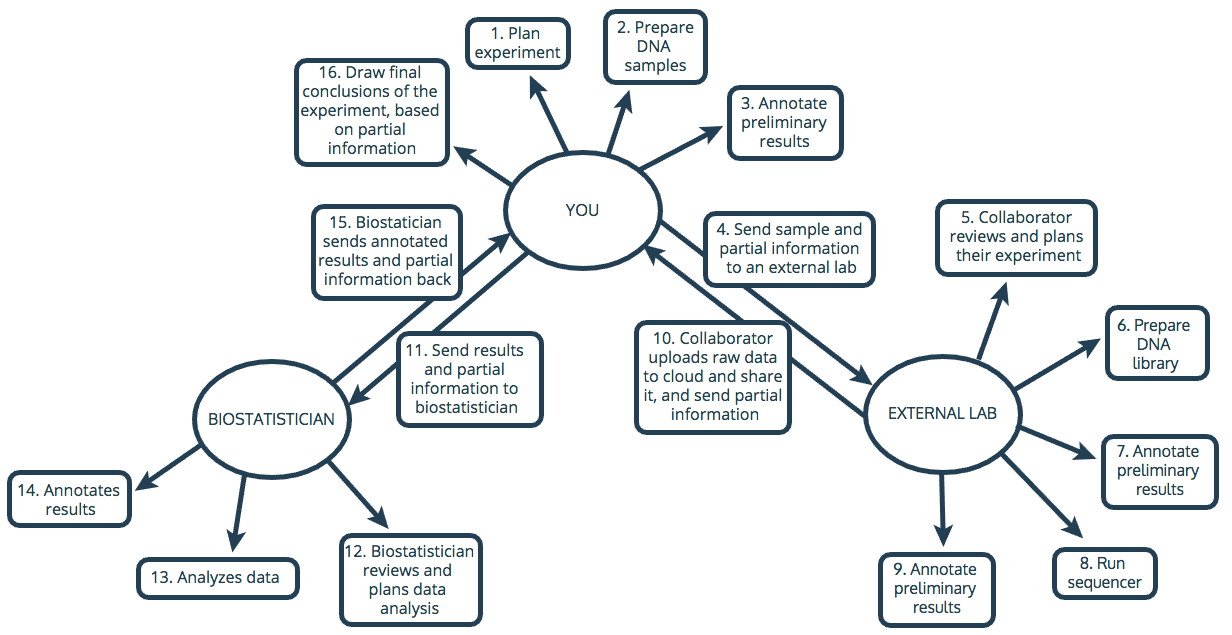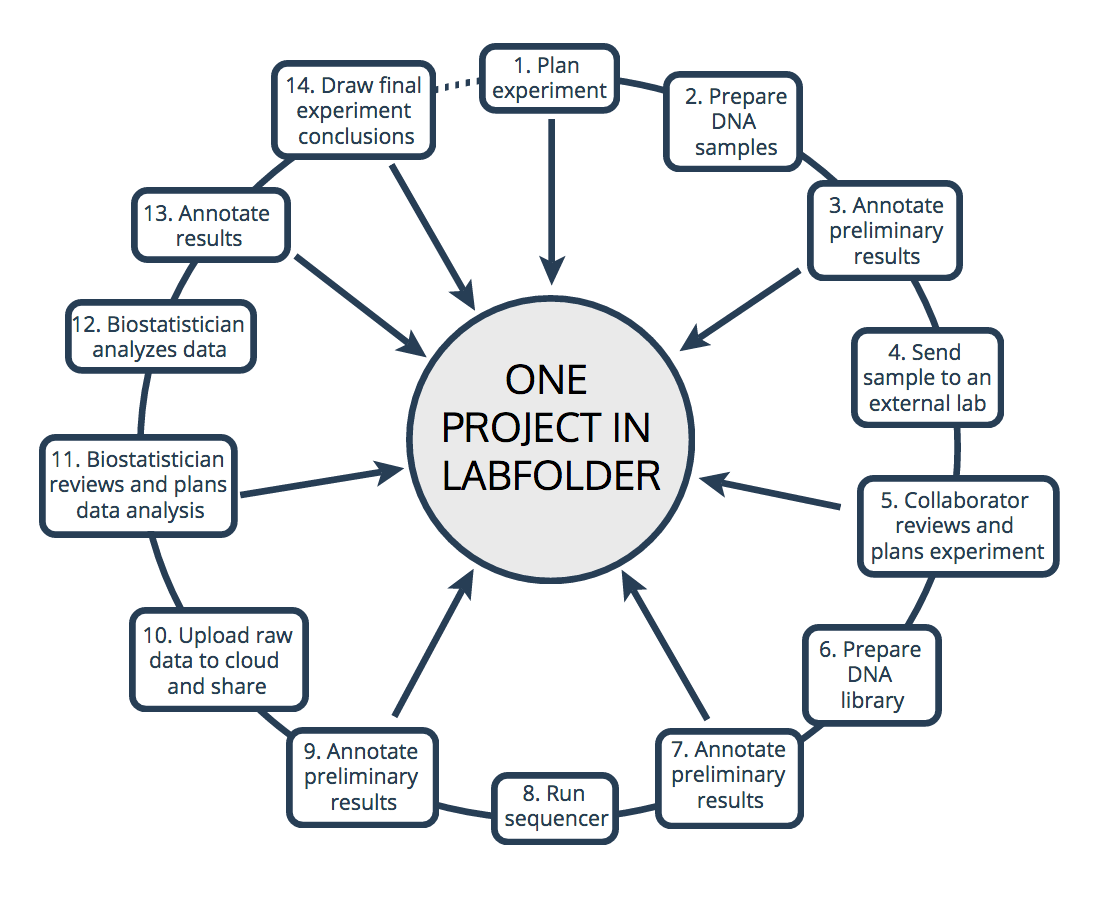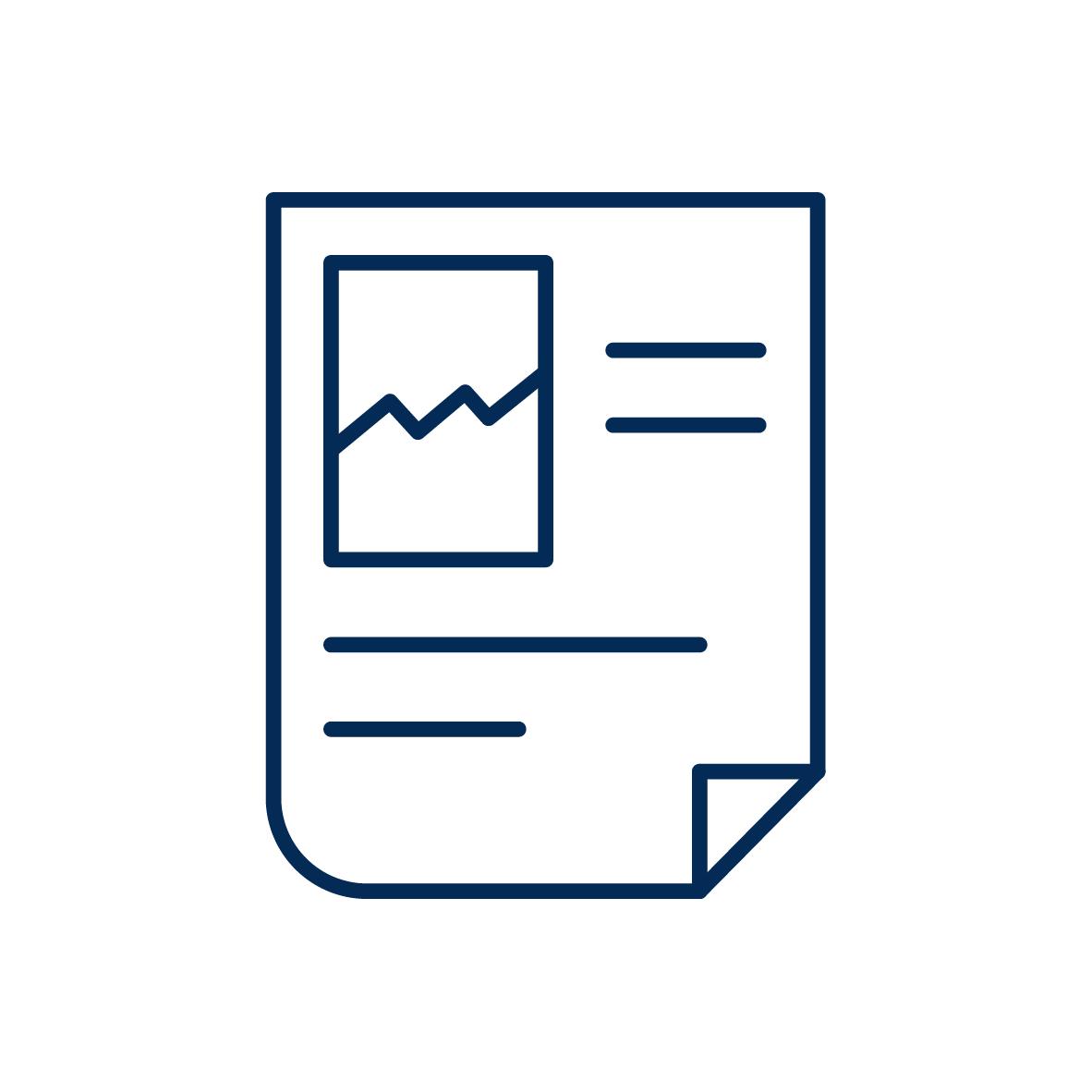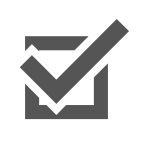In the last 10 years, NGS has become increasingly more prevalent in many laboratories worldwide. This technique is used for genome and transcript discoveries (de-novo or reference-guided assemblies, SNPs, variant identifications), enrichment sequencing (such as ChiP-seq), profiling of small molecules (smRNA and miRNA seq) and methylation and also for RNA sequencing.
The exponential increase in the use of Next Generation Sequencing is intrinsically related to the reduced costs of DNA sequencing from approximately 100 million dollars per genome in 2001 to a couple thousand dollars in 2016.

Source: NHGRI Genome Sequencing Program
Despite the positive trend, many labs still struggle with implementing NGS on their own and depend on the help of external groups owning NGS equipment, as well as bio-statisticians to assure that the large amount of data generated is rigorously analyzed.
Collaboration is the cornerstone of research but it needs to be managed properly. With so many stakeholders involved in a single NGS experiment, it can hard to keep track of progress. Efficiently sharing preliminary results and making sure that all team members are on the same page is a common pain point, as information is often scattered across different files and notebooks. We asked one of our customers to explain to us what their typical communication chain looked like, and then mapped it out. This is the result:

The above diagram highlights the complexity of the network needed to complete a simple NGS experiment. It is clear that the lack of a common platform where everyone can add their share of results makes success more difficult. It also damages productivity because you need to rely on partial information to draw conclusions and advance with your research.
When you partner with other researchers, you multiply the number of paper lab notebooks used for experimental recordings, regardless of whether we are talking about protocols, data, or conclusions. Because paper lab notebooks are physical objects that shouldn’t leave the lab, it is almost impossible to get a full picture of what your collaborators have done including the documentation of small issues, like the use of a different reagent when preparing one of the samples.
The implementation of a platform that works as a scientific hub and where all stakeholders can document their experiments in a single thread can not only expedite your data but also improve its quality. With labfolder, you can keep track of all the details in your project and quickly identify problems that can compromise the success of the experiment, and you can use the platform to maintain effective, ongoing communications with all partners that lead to new findings.
In NGS experiments, the generated data and the communication between scientists are digital, so it becomes counter-productive to maintain a paper lab notebook for documentation. In addition, with the constant improvement in interconnectivity between devices and software, one might expect that a direct communication between the NGS sequencer and the lab notebook is available. Popular suppliers such as Ion Torrent, Illumina, and PacBio offer the technology for automatic data extraction and its integration with platforms like labfolder.
By improving collaboration and communication workflows, labfolder scientists were able to simplify their NGS research management. This is how a single NGS experiment now looks like:

“We are working mainly in larger teams on several projects. With labfolder, everyone can follow and track the progress of each project. The digital lab notebook makes it easy to interact with other co-workers and also to add new team members to a project.”
Dr. Sven Wichert
Molecular and Behavioral Neurobiology Ludwig Maximilians University
“Since we’ve been using labfolder, it is much easier to keep track of joint research projects. It’s really easy to exchange data and work together with colleagues.“
Ingo Przesdzing
Histology Labmanager, Charité – Universitätsmedizin Berlin
 Know what is happening in each experiment. Each scientist can add their data and results to a shared project, accessible worldwide. No longer will you need to question what everyone is doing in an experiment.
Know what is happening in each experiment. Each scientist can add their data and results to a shared project, accessible worldwide. No longer will you need to question what everyone is doing in an experiment.
![]() All data is stored in a common place. This means that all the information needed is readily available when starting to write a paper or preparing a poster for a conference.
All data is stored in a common place. This means that all the information needed is readily available when starting to write a paper or preparing a poster for a conference.
![]()
Easily retrieve all different Ns with the search and filter tools. Retrieve and validate data from all scientists.
 With so many stakeholders in the NGS experiments, you can spend hours discussing results through endless email threads. With Labfolder, the data and discussions are in one place.
With so many stakeholders in the NGS experiments, you can spend hours discussing results through endless email threads. With Labfolder, the data and discussions are in one place.

Create and assign tasks to follow up on the progression of the work. There is always that collaborator that does not get things gone as fast as is expected of them. Tasks can assure that everything is done in time.
![]()
Use tags to focus on a specific workflow. By giving a tag with the name of the experiment to each entry, you will always find the entire workflow in a single view.
Productivity is key for science. With Labfolder you can spend more time on the bench instead of the desk. Since the NGS data is already digital, it makes sense that an ELN is used instead of a paper lab notebook.
Over 600 papers are retracted every year due to data inconsistencies. By having the content and data from all team members in a digital format, you can reduce the risks of a retraction.
NGS experiments mean data and in each single N scientists end up with thousands of data points. Labfolder can organize your research and avoid any stress in the future.


